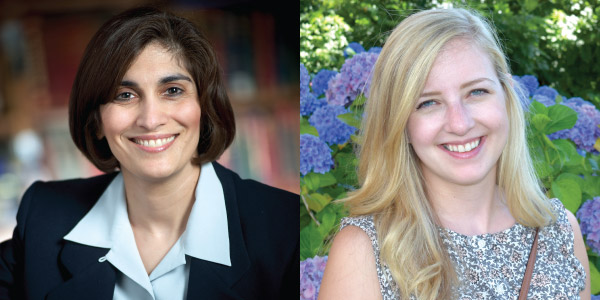Think-Pair-Share implemented in dentistry
Jessalyn King - 11 September 2020

Drs. Seema Ganatra and Tania Doblanko
Dr. Seema Ganatra, Clinical Professor in Oral Medicine and Pathology at the University of Alberta School of Dentistry, and Dr. Tania Doblanko, casual instructor at the School (and Ganatra's former student), have introduced a new seminar format as a component of the existing oral pathology course.
In this seminar, instructors provide actual patient cases to pairs of dental students (one in the third year and one in fourth). The students consider the case individually ("Think"), diagnose it in pairs ("Pair"), then share their findings with the rest of the class ("Share"). Ganatra and Doblanko then add a wildcard, which modifies the case with other scenarios, such as hypertension, street-drug use or telling a patient they have cancer, which affects the students' treatment strategy. Once the case has been presented, Ganatra explains how she actually managed the patient, adding a narrative storytelling component.
This format was inspired by feedback from Doblanko when she was a student in the seminar. She says, "As a student, I learned best when I was put in the position of formulating a clinical decision on my own, and then discussing my thinking process with an experienced clinician."
The presence of the "asymmetrical" pairs (from different year groups) provides a mentoring component. Ganatra says, "The third-year students are responsible only for a simple portion of the seminar presentation but can learn from their senior classmates."
Doblanko says, "This format brings more discussion about real-life clinical experiences into the seminar setting. The students benefit by thinking through treatment plans and discussing them with experts before they face these situations in private practice alone."
Dr. Arnaldo Perez Garcia, Education Research Methodologist with the Educational Research & Scholarship Unit (ERSU), helped Ganatra and Doblanko develop their seminar into a research study. He says, "The innovative thing about Seema's seminars is how many elements she was able to successfully combine to the students' benefit." The seminar combined Think-Pair-Share, narrative storytelling, mentoring, and the wildcard mechanism to have the students think on their feet.
This format challenges students' quick-thinking and knowledge application but is also a challenge for instructors. Ganatra says instructors need to be strict with time management while also redirecting students before they go off on tangents and making them feel comfortable enough to develop their own thinking. She says, "I think it's something every instructor can do, but it changes the way we look at our students and how we teach. It takes practice."
Ganatra's seminar is taught by two instructors, and she highly recommends the format to make students feel comfortable. One instructor guides the students and leads the group discussion, while the second participates and helps answer questions.
Since introducing this oral pathology seminar in 2017, Ganatra has implemented the format in her radiology course. Dr. Fabiana Almeida, who teaches a course on advanced radiographic imaging, has also requested assistance to implement it in her class. Ganatra says, "I envision this for every specialty, and not just in dentistry. Any class which uses case-based learning can incorporate this format!"
This is Ganatra's first foray into educational research, and she plans to continue. The team was able to present it at various conferences to great interest. She says, "I've had educators from other universities — in California, Puerto Rico and elsewhere — ask for help on utilizing the format in their classrooms."
Perez Garcia says the ERSU is considering building an online workshop to help other educators develop their own courses using these strategies.
Ganatra, Doblanko and the ERSU team have just published a paper in Teaching and Learning in Medicine titled "Perceived Effectiveness and Applicability of Think-Pair-Share including Storytelling (TPS-S) to Enhance Clinical Learning", which sheds light on the effectiveness of TPS-S and the conditions under which it can be implemented.